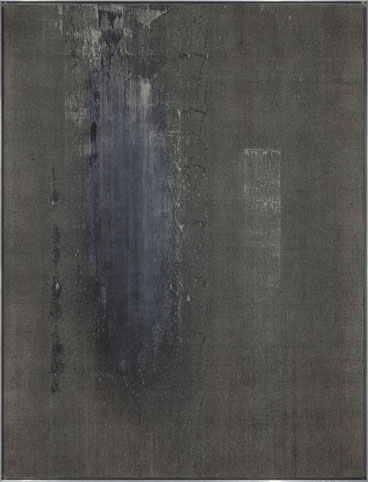Syntax
Kemal Seyhan’s paintings in the last two decades are narrated
with a narrow language, comprising four words:
horizontal-vertical-color-intensification
While he pieces the words of this narrow vocabulary together, the artist restricts himself with a series of rules: starting with black, applying vertical and horizontal on the canvas lengthways,
avoiding simple topological relations on the surface of the work –such as large-small, including-included, inside-outside; in this context, not using the color to define the space on the canvas
putting it mainly under intensification’s order creating an excelled surface that disables any 3D illusion, leaving everything else (except for the surface)
the back or sides of the canvas out of attention
The works are implemented by applying this vocabulary
and rules on canvas deck of times. Kilos of paint is used to color the canvas with thousands of spatula touches to create strata.
In the paper productions, Seyhan started to work on in
2009, the canvas (along with the paint) disappears as a
means of expression. Instead we find thousands of graphite
marks covering the paper laterally, horizontally and –at
times- transversely. On these works, turned into metallic
surfaces due to intense use of graphite, intensification -the
central concept of Seyhan’s vocabulary- is given a new
tool: The both-sided breaks (while drawing on and painting
it Seyhan also breaks the paper pushing it against a
sharp corner) create a sense of relief on the surface. As a
matter of fact, the rich topography of this relief imitates
the effect the perfected color intensification created by the
stratified paint applications. The semi-chaotic topography
of the production builds a strong communication with
light. Reflecting the colors of its environment, it presents
a different chromatic scale depending on the viewpoint
Autopoiesis
Except for a general intention regarding their dimension
and perhaps the color selection, the works do not have a
master plan. Countless layers generating the painting is resolved
with the guidance of the preceding strata and maybe
the micro-aesthetical, local preferences of the painter.
In these resolutions, what is visual is always behind (even
under the domination) of what is physical and psychical.
In one of his interviews Ginsberg says that while singing
his physical presence leads Bob Dylan to utter the air mass
with the correct physical features. This counts for Seyhan
too. He concentrates all his attention and bodily skills on
the 7-8 cm-long sharp edge of the spatula and on the pertinence
of the physical relation between the paint and the
surface. He then paints the surface numerous times from
one end to the other.
In this process, through which each moment is created after
discussing with the aggregate of the past moments, it
is evident that the syntax cannot set a rule to prioritize
the course regarding the completion of the works. In short,
like all organic processes (psychical or biological), Seyhan’s
works have a strong autopoietic nature. It is impossible to
tell when they are fully completed.
Semantics
At the end of the day, it is interesting to see an artist limit
her/himself with a narrow vocabulary, a very rigid syntax
structure and an unprogrammed process where instants
produce the following moments for a work which is produced
for communication with unknown viewers. Could
these works be the conveyer of any meaning other than
their production processes?
Yes and no.
Yes, because Seyhan’s works in fact do not make reference
to other concepts and problematic of any area other than
painting. They do not deal with the questions of the daily
or theoretical world.
No, because these works build a special communication
with the viewers standing (preferring to stand) in front
of them. This communication is nothing more than the
intense (yet not harsh) effect of stopping imposed on the
audience.
by Mehmet Budak
 Kemal Seyhan
Kemal Seyhan
